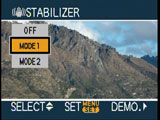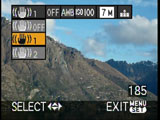Panasonic Lumix DMC-FX30
-
-
Written by Gordon Laing
Panasonic Lumix DMC-FX30 image stabilisation
Panasonic Lumix FX30 features
Lenses / Screen and menus / Sensor and processing / anti-shake
Like all of Panasonic’s current range, the Lumix FX30 is equipped with Optical Image Stabilisation (OIS) to counteract camera shake – and while the maximum focal length only has a relatively modest equivalent of 100mm, it’s still a very useful facility to have under poorer light conditions. So long as your subject isn’t moving, it allows you to avoid the higher sensitivities which, as you’ll see in our results pages, have a significant impact on image quality.

|
 | |
As with other Panasonic models, the FX30 features three different OIS options, accessed on this model either from a dedicated page or the dropdown menu – see left. Mode 1 applies stabilisation constantly, while Mode 2 only applies the stabilisation as you take the picture; the latter has the potential to be more effective since the system always starts from a central position, although you won’t see the effect as you compose the image.
Interestingly while we normally prefer Mode 1 on Panasonic’s super-zoom models, it’s not so important on the FX30 as it simply doesn’t zoom-in that far – so even at its maximum focal length, you’re unlikely see the effect of that much camera shake on the screen. So unless you’re wobbling a lot and can’t frame your shot accurately, it’s probably worth leaving the FX30 set to Mode 2 and enjoying a slightly more effective operation.
Panasonic Lumix DMC-FX30 Mega OIS off |
Panasonic Lumix DMC-FX30 Mega OIS Mode 1 |
Panasonic Lumix DMC-FX30 Mega OIS Mode 2 | ||
 |  |  | ||
| 4.6-16.4mm at 16.4mm, 1/13, 200 ISO | 4.6-16.4mm at 16.4mm, 1/13, 200 ISO | 4.6-16.4mm at 16.4mm, 1/13, 200 ISO |
Above are crops from three examples of a bottle label taken in macro mode with OIS disabled, followed by the two OIS modes. The crops are taken directly from the original images and reproduced here at 100%.
The images taken with OIS clearly show camera shake has been greatly reduced, and of the two options, Mode 2 does indeed show an additional benefit over Mode 1, confirming Panasonic’s claims. Assuming you adopt the popular theory of requiring a shutter speed of one over the effective focal length to avoid camera shake, then the FX30’s OIS Mode 2 appears to offer between two and three stops of compensation. Of course people and conditions vary, but this test illustrates the benefits of the OIS system, and once again confirms Mode 2 as the more effective option.
That’s it for the features, so now let’s take a look at how it performs in practice with our FX30 outdoor results.




